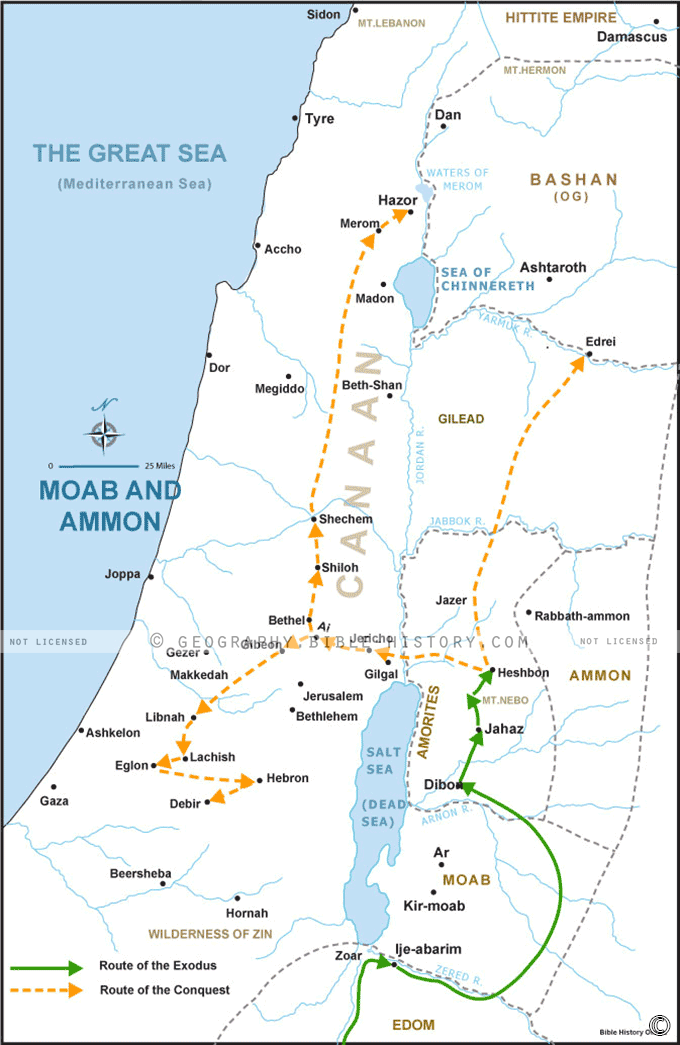
The Map of Moab and Ammon transports us to an intriguing and historically significant region in the ancient Near East. Moab and Ammon, two neighboring territories east of the Jordan River, are rich in history, culture, and biblical significance. Exploring this map offers a glimpse into the complexities of these lands and their enduring legacy.
Moab and Ammon: Geographical Context
Located in the eastern part of the Jordan River valley, Moab and Ammon were positioned strategically between major ancient powers, including Israel and the Amorites. Their geography, with rugged terrain and arid deserts, influenced their history and culture.
Ancient Peoples and Origins
The Moabites and Ammonites were descendants of Lot, the nephew of the biblical patriarch Abraham. These peoples established their own distinct identities, languages, and cultures over time. The Bible references their interactions with other nations, including the Israelites.
Biblical Significance
Moab and Ammon are prominently featured in the Hebrew Bible, where they are often portrayed in complex relationships with the Israelites. From the story of Lot's escape from Sodom to the accounts of battles and alliances, these lands are woven into the tapestry of biblical narratives.
Ruth and the Moabite Connection
The Book of Ruth, a beloved biblical story, centers on a Moabite woman named Ruth. Her journey from Moab to Bethlehem and her loyalty to her Israelite mother-in-law, Naomi, is a testament to themes of loyalty and faithfulness.
Conflict and Cooperation
Historically, Moab and Ammon both clashed and collaborated with neighboring kingdoms and empires, including the Israelites, Assyrians, and Babylonians. These interactions are recorded in historical texts and inscriptions.
Modern Landscape
Today, the ancient lands of Moab and Ammon are part of modern-day Jordan. The archaeological remnants of their cities, such as Petra and Amman, continue to be of great historical and touristic significance.
The Map of Moab and Ammon unveils a region rich in heritage and biblical history. It invites us to explore the dynamic relationships between ancient peoples and the enduring impact of their cultures on the world today. These lands, once centers of intrigue and conflict, now stand as testament to the enduring legacy of human history.
Blank Topo Map of The World
Abraham’s Journey
The Captivity of Judah (586-516 B.C.)
The Fall of Judah 586 B.C.
The Northern Kingdom of Israel
The Southern Kingdom of Judah
The Divided Kingdom
The Fertile Crescent
Ur of the Chaldees
Shechem in Old Testament Times
Prophets, Kings, and Nations
Jesus Last Passover
New Testament Israel
New Testament Places
Old Testament Israel
Provinces of the Roman Empire
Israel during David’s Kingdom
David’s Kingdom
Cities of the New Testament 4
Cities of the New Testament 3
Cities of the New Testament 2
Mediterranean Sea
Cities of the New Testament
First Century Jerusalem
Empire of David and Solomon
David’s Kingdom
Israel Under Rehoboam
Ophir and Tarshish
The Period of the Kings
Ramoth Gilead
Samaria
Solomon’s Temple
Zarephath and MT Carmel
Jabesh Gilead and Tribes
Judah in the Time of David
Kingdom of Saul
Kirjath Jearim
Michmash
Mount Gilboa in the Time of David
Nob Davids Flight
Shiloh
Israel and Judah
Assyrian Empire Under Esarhaddon
Assyrian Empire Under Sennacherib
Captivity of 10 Tribes
Events in 2 Kings
The Khabur River
Israel and Syria
Captives From Judah
Kingdom of Jeroboam
Mesha’s Kingdom
Pharaoh Necho Battles King Josiah at Megiddo
Babylonian, Mede and Persian Empires
Samaria and Nearby Territories
Syria at its Height
Hebron
Mahanaim
1949 Map of Israel With Boundaries
First & Second Journeys of Paul
Journeys of the Apostles
Paul’s Third Missionary Journey
Saul’s Journey to Damascus and Arabia
Paul’s Final Visits
Paul’s 1st Missionary Journey
Paul’s 2nd Missionary Journey
Paul’s 3rd Missionary Journey
Paul’s Voyage to Rome
Phillip Journeys to Samaria and Gaza
Judah at the Time of Amos
Empire of Alexander the Great
Israel Under the Maccabees
Galilee During Maccabees
Idumea Intertestamental Period
Kingdom of the Ptolemies
Kingdom of the Seleucids
Ptolemaic Egypt Seleucid Asia
The Roman World
Kingdom of Ptolemies and Seleucids
The World During the 6TH Century BC
Mount Horeb
The Red Sea
The Exodus
Ezra’s Journey to Restore Jerusalem
Israel and Judah During Hosea’s Time
The Ancient World
Canaan During the Time of Abraham
The City of Shechem
Supposed Location of the Garden of Eden
The Land of Israel in Genesis
The Jordan River
The Kingdom of Nimrod
Mount Ararat and Mesopotamia
The Descendants
Sodom and Gomorrah
The Kingdom of Egypt
The Hamites
The Kingdom of the Hittites
Ur of the Chaldees
Judah at the Time of Haggai
Jesus Passes Through Samaria
